How To Get Mold Out Of Clothes and Fabrics
This post may contain affiliate links. Read our full disclosure.
I went through Moldageddon in 2014 and since then have learned more than I ever thought I would ever need to know about mold. I know how to prevent mold, how to test for mold, how to clean mold, how to detox from mold exposure, and gobs more.
But what about clothing? Can you remove mold from clothes and other fabrics?
The short answer is sort-of. I know. You wanted a hard and firm yes. Yes you can remove mold from clothes and save your favorite shirt. But unfortunately, there is always a risk that comes with trying to make moldy items safe again. This is mainly because of mycotoxins – the evil spawn of mold. Those suckers don’t budge. Once they make a home out of your belongings they stay fairly well put despite your best remediation and cleaning efforts. Their favorite thing to do is wreak havoc on your health…hence why cleaning anything moldy presents a risk.
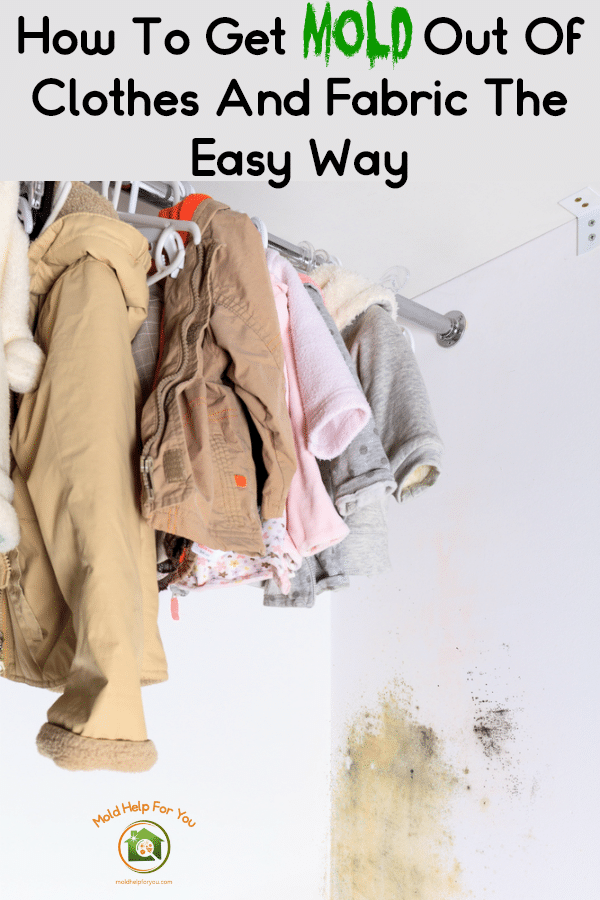
Some moldy items can be cleaned properly and saved. Typically these items are non-porous items which clothing clearly is not. Clothing and other fabrics are as porous as it gets. I walked away from everything after Moldageddon and had I kept anything, clothing would not be at the top of my list. However, I get it. Not everyone has severe health issues from toxic mold exposure. Not everyone can afford to or wants to start life all over again with nothing.
So how do you remove mold from clothes and are they really safe afterwards?
Method #1 – EC3 Laundry Additive
This is the ONLY way to remove mold from clothes that I would ever recommend. Not only has it been proven to reduce the number of mold spores on clothing but it also gives mycotoxins a run for their money. You can view the report from Real Time Labs below. Yes, they tested the EC3 candle and EC3 mold solution concentrate and not the laundry additive, but the ingredients are virtually the same.
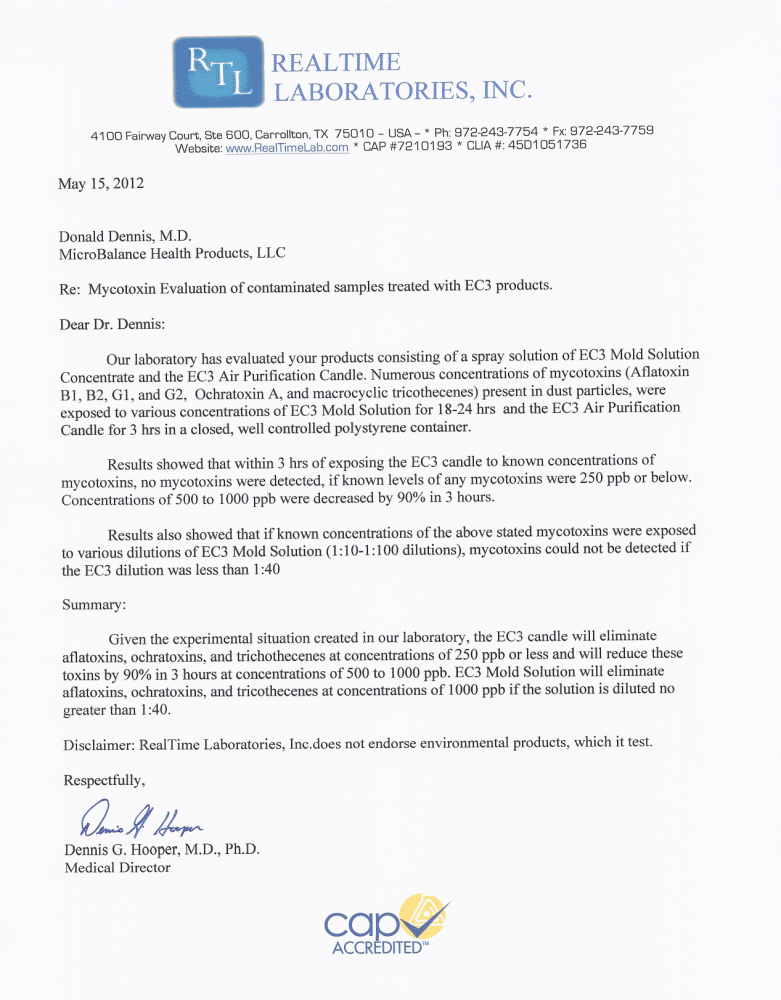
EC3 Laundry Additive is formulated to add to your washing machine rinse cycle to rinse away mold, bacteria, and mildew along with the “musty” and “putrid” smells that remain on clothes even after washing them. Fabric and textiles, including athletic and outdoor work clothing are vehicles for mold and bacteria to remain close to your body.
EC3 Laundry Additive helps rinse away bacteria and mold spores that find a home on your clothes. Most laundry detergents alone often fail to eliminate mold. It also replaces fabric softeners that often serve as food for mold. You all knew this about fabric softeners right? They are food for mold spores. They also make you a walking candle… fabric softeners make your clothing flammable. But I digress.
Let’s look at what EC3 Laundry Additive is all about
- It removes mold from clothing and fabrics
- It removes bacteria from fabrics
- It eliminates musty and putrid smells caused by mold and bacteria
- It is safe for all regularly laundered fabrics
- There are no harmful chemicals, synthetic perfumes or dyes
- It works with HE appliances
- It contains distilled water, Tea Tree Oil and a proprietary natural botanical blend of citrus seed extracts.
I have used this product on some “questionable” items that I purchased used. I react instantly to mold and was having some warning signs after purchasing the clothing items. After two washes with EC3 Laundry Additive, my clothes smelled amazing and I had no reaction when handling or wearing them.
My opinion – EC3 Laundry Additive works to remove mold from clothes. I also believe it does a good job of getting mycotoxins out. I wholeheartedly recommended trying this product IF you are not in a position to leave your belongings behind, are currently living in a moldy environment, or find yourself in possession of a fabric item that is questionable. I will still always advocate for disposing of porous items that are moldy or are residing in a contaminated environment.
If you want to learn more about how the EC3 products work, please visit that post! You can purchase directly from Micro Balance with free shipping too!
Method #2 – Ammonia
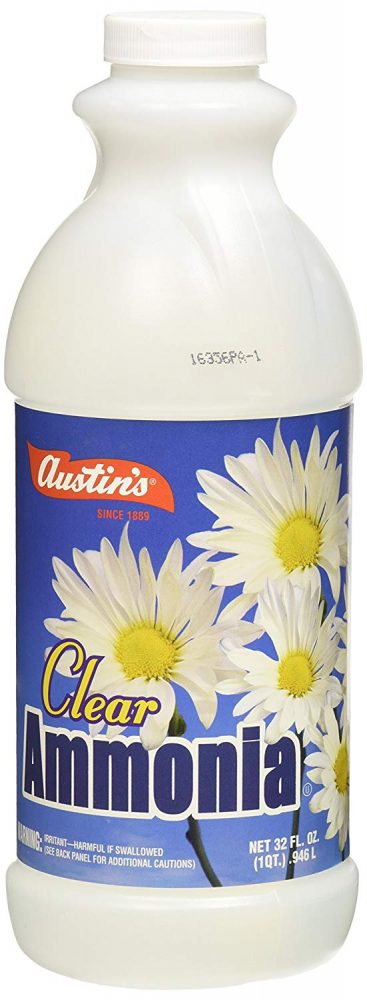
If you are reading this you have surely heard about using ammonia to remove mold from clothing. Before we get into this more, let me tell you a little story.
After we moved to our second temporary living space after Moldageddon, I decided to play it safe and wash all of the linens in ammonia. The place we rented was furnished and after lots of research (and before I knew about EC3) I decided ammonia was the best possible chance I had of removing mold from fabrics.
I almost killed myself that day. On accident of course. Do you know what happens when you wash your clothes in a small apartment with LOTS of ammonia? You practically suffocate from the fumes. It takes less than 5 minutes for those fumes to overpower the space. I got myself, my daughter, and our rabbit our of there pronto. It tooks DAYS of airing out the apartment to clear it of that noxious, toxic odor. My lungs and eyes burned for a couple of weeks. It was brutal.
Basically, this told me all I needed to know about using ammonia. I was likely doing more harm than good by washing fabrics and clothing in it. I mean, how can something that produces those kind of fumes be healthy to use?
So why did I use ammonia to remove mold from clothes in the first place?
Based on the research of Dr. William Croft, I learned that ammonia has been used in the food industry for centuries to kill small concentrations of mold spores and to “chemically inactivate” mycotoxins. Ammonia is actually the only known (natural) substance “to us”, to actually change the molecular structure of both the spore and the mycotoxin metabolite.
The agriculture and farm industry have known this for centuries. This is why they treat a lot of your food and grains with an ammonia wash before bringing it to the general public. Ammonia is what protects humans and animals from dying of mycotoxin poisoning in our food. In fact, ammonia is produced by animals, plants and in the human body (think urine) and is safe for us to consume when used in this manner – apparently.
Here’s the kicker and why I had such a horrid experience.
Mixing chlorine with ammonia is dangerous. Most “City” water is treated with chlorine. If you do not have a water filter that removes chlorine, the ammonia and chlorine will mix and create a very toxic gas. Ahem. Hence why I almost killed myself on accident.
Because of this, I just cannot recommend using ammonia to remove mold from clothes and fabrics. That EC3 solution is 100% safe in any water. So why compromise your health further?
If you MUST use ammonia, here is the proper way to wash your fabrics.
Wash each load in 2 cups household ammonia for every load. Household ammonia is diluted to 3% – 5% concentration. DO NOT USE ANY OTHER DETERGENTS OR CLEANERS. Detergents add chemicals which will then change the molecular structure of the ammonia and make it non-effective against mold spores and mycotoxin metabolites.
Temperature DOES NOT effect mold spores or mycotoxin. Items can be washed or soaked in any temperature.
After washing the load in ammonia, rewash with a natural detergent (like this one) to remove any lingering ammonia.
Be sure to read my entire post on Does Ammonia Kill Mold.
Method #3 – Vinegar
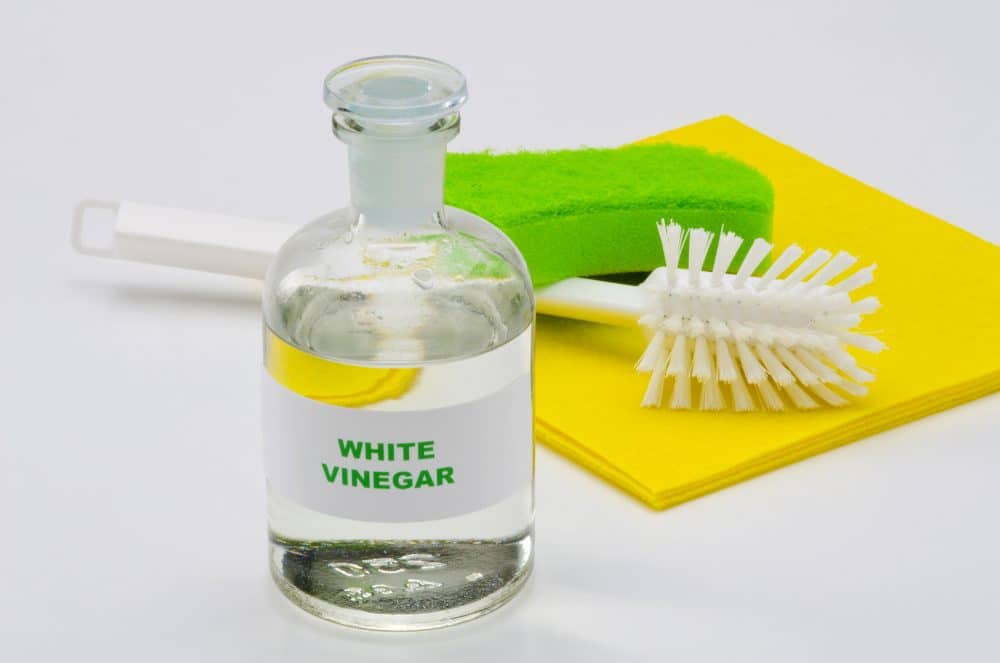
Last but not least there is the vinegar method for removing mold from clothes.
Vinegar kills 82% of mold species and can usually kill the mold growing on clothes. Notice how I wrote usually? This is because it doesn’t kill all mold species and there is zero evidence that I has the power to remove mold spores like EC3 Laundry Additive and ammonia. Vinegar will however remove the moldy smell from the clothes.
How to wash your clothes with vinegar:
- Put your clothes in the washing machine and let the machine fill with hot water.
- Add about 2 cups of vinegar to your washer.
- Allow your clothes to soak in the washer for an hour.
- Let the washing machine run through its cycle as normal.
Most people find that they need to repeat this process several times. Others simply line dry their items outside and allow the sun to continue killing mold spores.
The takeaway from all this? There are ways to remove mold from clothes. With method #1 and #2 it is likely that you are also removing mycotoxins. Trying to save porous items is always risky and may backfire resulting in additional or prolonged health issues. If it were me, I would stick with the EC3 Laundry Additive and avoid the ammonia and vinegar methods.
Is your washing machine moldy? Be sure to read my post on how to remove mold from a washing machine. It does you no good to wash clothing in a moldy washer.
Thoughts? Questions? Comments?
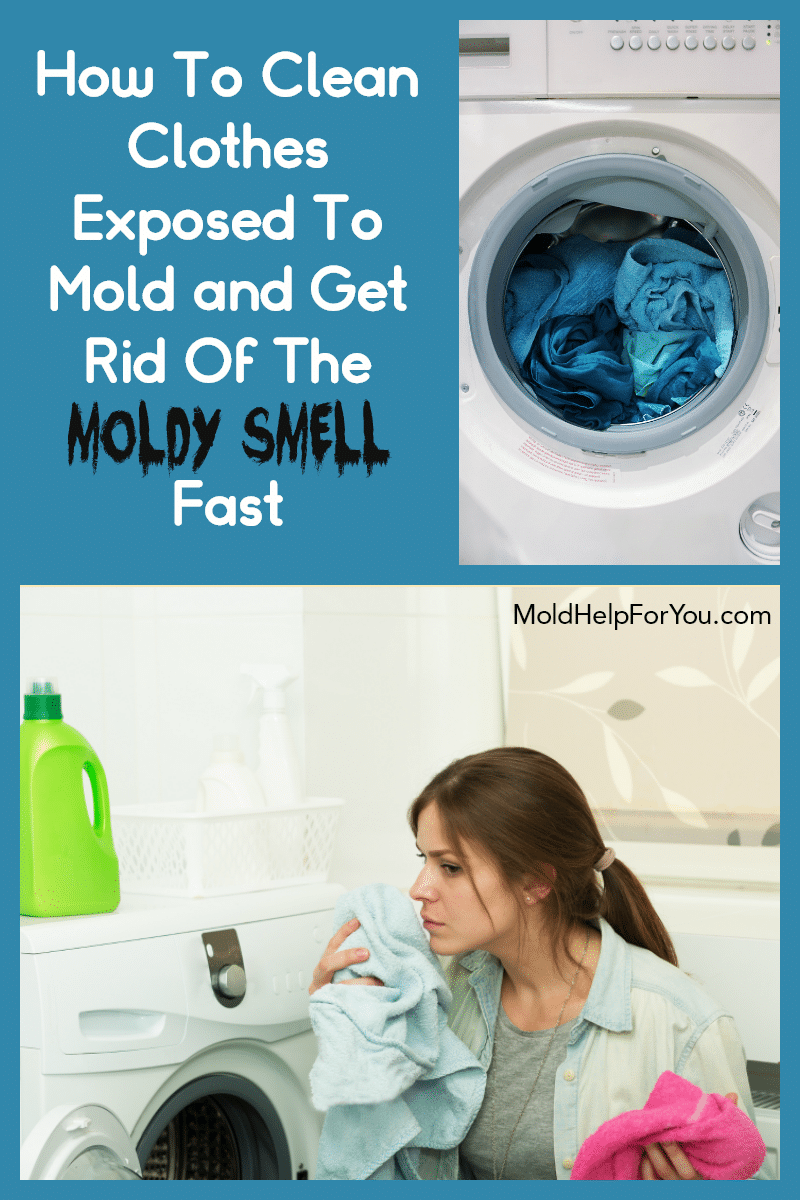

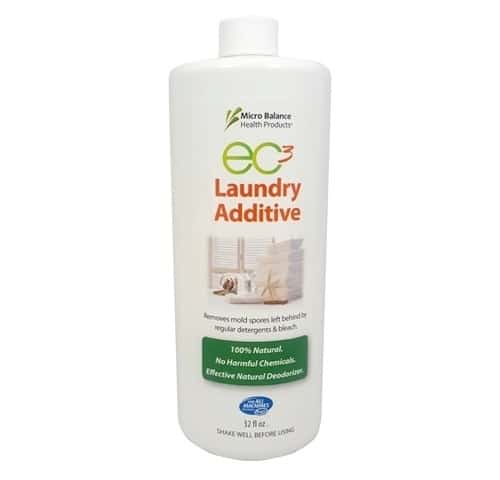
Can apple cider vinegar be used in place of white vinegar?
Hi Kim! ACV doesn’t quite have the same profile as white vinegar but yes, you can use it instead. The common complaint about ACV is that it leaves behind a slight ACV smell that white vinegar does not. Otherwise it does the job!
Hi Jennifer, thank you for your posts! I have Lyme disease and am very sensitive to mold. Last year we discovered mold in our washing machine which I’m assuming left mold spores on all of my clothes. Though there was never any visible mold or smell on anything I had to replace my entire wardrobe and get a new washer. A year later and we thought we were doing everything to prevent mold growth in the washer (leaving door and drawer open), and we discovered some in the gasket and am guessing there is some in the drum now. A few decent loads of laundry I have done are now giving me reactions. I tried the ec3 laundry additive last year, although I do not know if I did it correctly, but no luck. I want to try it again, do you have suggestions beyond just adding it with your detergent? Thank you!
Hi Wendy! It sounds like you are still battling mold in the washing machine which of course is cross contaminating your clothing. While the EC3 Laundry Additive is helping, it has it’s limitations when there is mold in the washer. Have you read this post on my site? https://moldhelpforyou.com/washing-machine-mold/ If the mold is really severe, I would just get a new washer. I went with a top loader and it has been a dream! Not sure if you have a front loader or not but it sounds like it. As for tips on the EC3. I would get a big plastic tote. This is going to take some effort but it should work better for you if you are reacting. Fill it halfway with laundry. Add water until it reaches about 2 inches below the rim of the tote. Instead of using the Laundry Additive, pour in 2 tablespoons of the EC3 Mold Solution Concentrate. Put the lid on and allow to soak for 30 minutes. Launder as you normally would with the EC3 Laundry Additive. If you replace the washer, you will absolutely want to do the clothing soak (as well as towels and other linens) before laundering anything in your new machine. You also want to increase the EC3 to 3 tablespoons. Let me know if you have questions! Hope this helps. 🙂
Prefilling the washer with moldy clothing with fresh water. You have just fed the mold with fresh life giving moisture. In a Ideal situation you would want your destructive medicine to go into dry mold spores. Try mixing your destructive medicine in a bucket then pour this into your then empty dry washer fill to the desired load size, mix, then add contaminated ″dry″ clothing to your toxic solution…
Hi Joe! There are a lot of mold avoidance folks who do exactly this. The reason I have not included this methodology in my post is because most people view this as “extreme.” A lot of people already view this process as a bit too much. However, your comment is a good reminder that it is worth mentioning as a solid approach!
Wendy again! I forgot to say that we are going to either replace the washer (again) or try to take the drum out and clean it before trying to get it out of the affected clothing. I am so scared of just trying to clean it but not actually being able to see if the mold is gone, and then ruining even more clothes.
Moving forward I will do the cleaning maintenance to prevent mold growth. Thanks again!
Do not buy “front load” washing machines, which harbor mold and break regularly.
Do not use the same hoses when there was mold in that washing machine then it is easily being in the hoses as well if it is the type of mold that requires to “do setting about” other then simple 2-7-day soak with gallon of vinegar.
Hi! Thanks for this article. So we had mold in our house. Not to much. Mainly the windowsill, bottom of the blinds and a tiny bit in the corner of our room. How do I know if my clothes have been contaminated? They were not touching the mold and most all do not smell. I don’t want to go bananas freaking out and thinking it’s all contaminated. Thoughts?
Hi Solana! I am hoping that the mold has all been removed at this point? Don’t rely on smell… mold can smell like any number of things or nothing at all. Most likely your clothing is fine. If you aren’t noticing any health issue or aren’t reacting to your clothes, then you should be ok. You can add EC3 Laundry Additive to each load just in case and that should take care of any cross contamination that might have occurred!
I have used vinegar and borax in laundry with some success. More so than the EC3, I regret to say.
I read that the PH of each of those substances is critical to killing the mold, but each substance is on the opposite end of the PH spectrum Would that mean that they would cancel each other out and become less effective than either one separately? So maybe it would be better to do 2 washes in sequence, one with borax and one with vinegar?
What are your thoughts?
Hi Sandra! Great comment and questions. This ALL depends on what types of mold you are dealing. Each mold has it’s own chemical composition. While overall, EC3 will work on all types of mold there are some people who have felt that it really didn’t help them with their laundry issue. This can be a function of your water quality. So let’s assume that maybe this is what is going on for you. There may be minerals in your water that are preventing it from working optimally. If you are seeing success with the borax and vinegar, I would add the borax to the regular wash and the use the vinegar in the fabric softener or bleach tray. If this is not available then you can add borax to the load of laundry, wash as usual, then start a second “rinse” cycle with the vinegar after the initial load is complete. Did that make sense?
I heard lemon juice gets mold out of clothing. Does it work? and how do you use it?
Hi Doris! Unfortunately, lemon juice does not get mold out of clothing. The only way that citrus works is if you are using a citrus seed extract. This will disrupt the cell membrane of the mold spore, effectively causing it to die.
Thank you for this great article! I’ve got mold toxicity and am trying to decide which items to just move on from. Would you recommend I leave behind my wooden kitchen table, leather chair, and wood bed frame? Mold spores can sink into all of these materials, right?
Hi Elizabeth! So sorry you are going through this. Wood is definitely very tough to remediate and something I suggest throwing out. Leather has a better success rate if it is smooth but can still be problematic. I personally would not try to salvage these items.
hi I just discovered you on the web. I have have lyme. I went into a basement in an area we don’t use inside our mother in law 870 SQ ft structure. I don’t frequent it very often. It’s smell is Overpowering. I pulled out seven or eight boxes out of the basement I probably still have about a hundred within the basement. About 30 seconds of entering the basement to get the first boxes I began to be overcome and felt weak. I’ve been sorting through things basically looking for any things that I may have kept in pockets and am so sick and so weak in my knees that I feel like falling down. Water doesn’t taste good food gets my stomach upset. When I walked in the detached house, that we live in next door, all I could smell was the same smell as the basement. I know I’m off gassing. I just rinsed with a saltwater solution in a neti pot. That helps some with my sense of smell but the rest of my body feels weak after looking at clothes and whatever was in the eight boxes in 3 hours. We have a contractor working in the basement now. He’s installing a fan to evacuate aire at 60% humidity automatically. And he doesn’t feel very good either, he says the mold is affecting his lungs. Do I have to tear down my mother-in-law building? It’s a two-story, very cute with a loft, and a high ceiling on the second floor. I would love to know how to prevent losing a whole building. Thank you for answering.
In this case, it would be worth hiring a mold inspector to come in and access how bad things are. Basements are notorious for mold contamination so there is a strong likelihood that you will need to do some tear down. But I wouldn’t make that decision without having it professionally inspected.
Hi Kim this is Trey again and I wanted to know how you detox to the micro toxins out of your body.
Because I have Lyme and I’ve lived where it’s a damp climate I seem to just react to anything.
I have very weird things happening in my body and have been informed that if I don’t get out of mold to mold could end my life. We are completely renovating the house and I’m hoping that I don’t have to move away in a hurry. I can no smell mold which I could not do before moving here eight years ago. I have been practicing grapefruit seed extract intake and systemic enzymes. I would like to know more. I know you’re not a doctor I just am looking for your testimony of what you did and how long it took before you had relief. Thank you
Hi there! I keep anything health related off this site and on my other site. You can find my story of how I detoxed here: https://hybridrastamama.com/need-to-detox-from-mold-exposure-heres-how-i-did-it/ I hope this helps and I am so sorry you are going through this!
Hi, i have clothing, shoes and handbags, along with paper files etc that were put in a garage and they all share the very same awful pungent smell. They do not show any visible signs of mold or mildew but i am guessing that this is what the smell is from. The odor is gone from the clothes that permitted use of bleach in the wash. I washed other items that could not be bleached in reg detergent with oxyclean, or vinegar on colored items, 2 times, removed the clothing, then ran an empty load of bleach to clean the washer, then ran the load of clothes again with vinegar! Then of course washed the clothes again with more vinegar and Tide detergent. The smell is gone. The Question is, are the mold spores and mycotoxins gone? I also put my handbags in the freezer overnight – it seems to have helped.
Hi Kim! Easy answer first – a lot of people like to freeze items to remove mold. For many types of mold and some mycotoxins, this should work. So it is possible you were indeed successful with this method.
As for your clothing, bleach is 100% not the best thing to use. In fact, mold spores replicate in the presence of bleach. While this would not happen to the clothing you are washing, it could increase mold growth inside your washing machine. Here is the tricky part as well – traditional detergents like Tide leave a residue on clothing that spores like to cling to. More than likely, you still have mold spores and mycotoxins on your clothing although the vinegar absolutely would have removed SOME of these. The smell may be gone but there are likely still some spores.
Hi Jennifer….I have a situation where I feel as though my washer is contaminated….everything that is washed in it burns my skin. It was not like that previously…but I feel like something was washed in it that might have contaminated it. this has happened to a bunch of washers/dryers for me over the past 6 months….I get very reactive to clothing and if I try to wash them in a washer or by hand with EC3 and some other methods I still can’t wear them. This has affected my sheets towels…etc….and all my family’s laundry as well. Please let me know if you have any advice. Getting a new washer is an option but as soon as anything is put in there, I fear we may ruin a brand new washer…. I have basically been wearing clothing and having to throw it out after wearing it I’m so reactive sometimes.
I was given new clothes from a friend, I think they stayed in her molded home to long. Not knowing. I put them in dryer w/ febreeze, at the time didnt think about mold. Threw clothes out,
my question is should I throw out dryer. I need answer immediately. Thank you in advance.
Hi Octavia! Did you wash the clothing first or just put it in with Febreeze to knock out the odor? If the clothing was not laundered then I would be concerned about the dryer being cross contaminated. You don’t have to throw it out but you do need to clean it with EC3 Mold Solution. Every nook in cranny inside of it needs to be cleaned. Special attention would need to be paid to the lint collection tray.
Hi Jennifer… Thank you so much for this site! It is crazy-making trying to find actually science-backed and up-to-date information on this topic which significantly impacts home and health. I really hope you will be able to offer some clarification on some of your recommendations and concepts you’ve shared and address some other questions I couldn’t find elsewhere.
In the laundry article above, you feature EC3 and Ammonia, but on your products page you list Remedy as your number one choice for laundry. Then on Remedy’s website, they have this blurb “Visible mold is a sign of actively growing mold on the fabric and most likely cannot be treated.” This confuses me deeply and seems strange …If it is a product that treats mold (and mycotoxins) why wouldn’t it work? Can you clarify your understanding and position here?
I have 3 kinds of clothing mold I’m trying to deal with A. I accidentally forgot some clothes pretreating in a small bin for about a week and visible mold is evident (clothes had been rinsed and scrubbed and left for stain pre-treatment to work), B. Extremely damaged clothes from a long-time water leak in storage unit (these clothes are very special collector, vintage, items which have been sequestered in plastic garbage bags waiting for remediation if possible) and C. Clothes that seem clean but have a funny smell. I am intrigued by using the “plastic bin” method with the “EC3 Mold Solution Concentrate” which you mentioned above for some or all of these issues if neither EC3 nor Remedy would likely work for these situations. And then, use either EC3 or Remedy for clothes and washer maintenance. Do you think that’s a reasonable plan? What is your recommendation for these?
If I did use the bin and EC3 concentrate method, could you provide a more specific measurement so I can apply it to different sizes and loads?
Also, does the EC3 have to be disposed of down the drain or is it safe to pour outside if I were to do some soaks outside? (I have the heavily damaged bags in the garage and wouldn’t want to bring them inside. I’m wondering if I have to do soaks small enough to be able to carry the bin inside post soak to dispose of water or if I can dispose of soak outside without having to bring in.)
Finally, can you clarify about mycotoxins? If I cleaned mold in the past with just a mold killing method (like Borax or vinegar) and not mycotoxin killing solution, does that mean the toxins are still in there, presenting health issues and spreading to other items, or that more mold can grow specifically from those mycotoxins?
Thank you, thank you, and thank you in advance!
Hi Jennifer, thanks for the great post! With the ammonia would I need to dilute it with water ?
Hi there! Are you referring to the ammonia that goes into the washer? If so, then no dilution.
I recently purchased a cotton comforter online and I am suspicious that it has previously had mold. There are blackish spots on it that are similiar to what I have experienced in the past when I had this kind of damage from things being in a damp basement. Upon opening the box, the musty odor was overwhelming, the odor I am familiar with from things stored in a damp basement, etc. It appears to have been washed, and my kid thinks it smelled faintly of bleach. After having out of the package for an hour or two, the odor did not go away. Unfortunately the seller will not take it back so I want to know if this could be salvaged and be a safe item to have in my home, since it is something that is more than one layer and has filling. Right now, it is in the box it came in, but I’m not sure if it is even safe to have inside the house before treating?
Hi Kay! I would 100% go after the seller on this! If they are selling you something moldy, they have a responsibility to take it back. I absolutely would not use this or bring it into your home.
Hi Jennifer,
We found some white-ish mold on items hanging in our basement level bedroom closet. Do we need to wash everything in the closet for mold or just the items that we can see mold on (and the other garments touching those moldy garments)? Do we need to worry about things outside the closet too – sheets, pillows, mattress?
Thank you so much!!
Last month I left a blouse soaking in water and forgot about it. Afterwards I washed it out, hung it up, and took it down dry, but whatever was living in that water left my blouse smelling like excrement. So I looked online to see what laundry soap will get that smell out, and what I saw recommended was soaps with enzymes. I’m super leery of stuff with enzymes and am thinking of trying the stuff you recommend for mold (which I’m probably going to buy for moldy clothes–AND maybe a suitcase, too–ANYways). So I’m interested in knowing what you think.
Thanks for this article. And there is so much important content in the comments! Consider updating the article to clearly discuss vinegar and Borax. We are using this method as we do NOT tolerate tea tree oil which is in the EC3 laundry additive. Do you know which molds are killed effectively with vinegar and mold? We tolerate the BioBalance products. Could I use their “HavenClean” product with laundry? Do these citrus seed products bleach fabrics?
Hi Mimi! I try to keep my articles as concise as possible lest I loose people. 😉 Here is my article on vinegar: https://moldhelpforyou.com/does-vinegar-kill-mold/ Here is my article on borax: https://moldhelpforyou.com/does-borax-kill-mold/ I also have a great article here which does discuss borax and vinegar for laundry. It also has a detergent recipe in which you can omit the TTO. https://moldhelpforyou.com/best-laundry-detergent-to-remove-mold/ I would use this recipe over using HavenClean in the laundry. And no, Citrus seed does not bleach fabrics.
Do you like EC3 laundry additive or Citrisafe detergent better? On the products you love page it says that Citrisafe is your top product. How do you clean your clothes after a mold inspection? Thanks!
Hi Tim! Personally I like to just use the Citrisafe detergent. EC3 works great but you also have to use a separate detergent. As for cleaning clothes, if you use the Citrisafe, just launder using the instructions in my article. Nothing fancy.
Hi!
I have a question regarding this…
I left a moldy house without knowing the consequences of mold, so I brought everything with me.
I will be moving again and leaving all I can behind (sofas, mattresses, pillows, bedding etc).
I want to be as safe as possible but I am wondering how intense I need to get.
There is no mold in my present house but I believe we are suffering from the leftover mycotoxins on everything porous.
So I will leave all of that behind before moving again.
Now do I have to get rid of what I acquired here too even if there is no mold?
Like the new clothing?
I will get rid of everything I bought when I was in the previous home.
But the new clothing will have spent a short amount of time with the old clothing in my wardrobe.
I was thinking of washing the new clothing with the EC3 soap before moving. Can it have been cross contaminated by mycrotoxins from the old clothing even if there is no apparent sign of mold anywhere?
And what about books?
Can I clean book covers etc? From old house and new ones acquired here?
They are the only things I am attached to. I can part with everything else.
But my mycotoxin levels in my body are through the roof so I want to be safe. Thanks!!
Anything you can wash in EC3 should be fine. I have done before and after swab sampling and it works beautifully. Books are a little tricky because mold spores and mycotoxins love book binding glue. Some clients I have worked with have done a protocol using ozone and had great success. What they did is get a large plastic storage box with a tight fitting lid. They used this portable ozone machine: https://amzn.to/3OYTqK4 You cut a really small hole in the storage box to run the tube into. Seal with tape around it to prevent any leaking it. Put no more than 20-25 books at a time depending on size. You need space around them. Run for an hour. Wipe all the covers with EC3. DO NOT DO THIS INSIDE YOUR HOUSE. This is an outdoor activity.